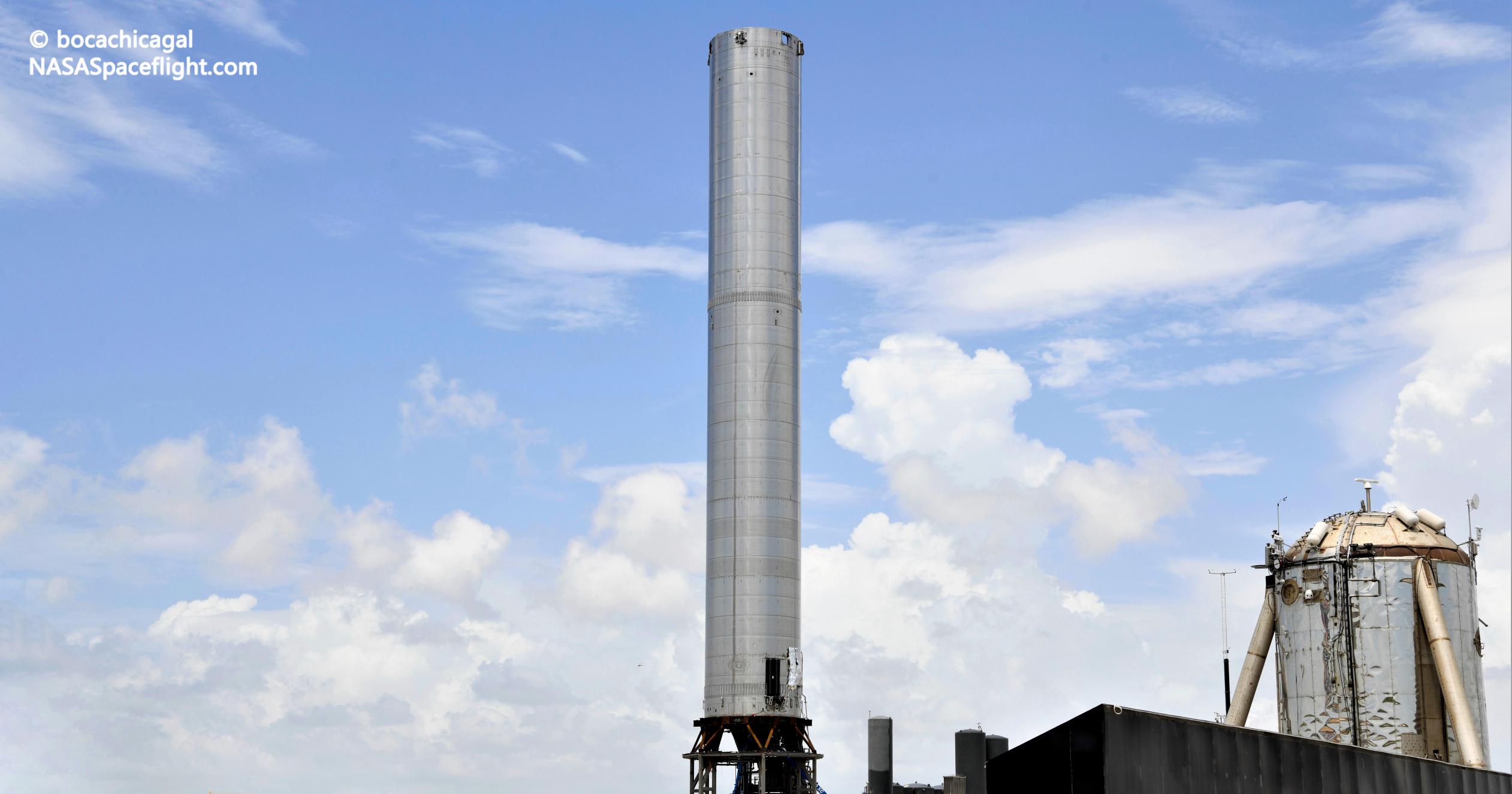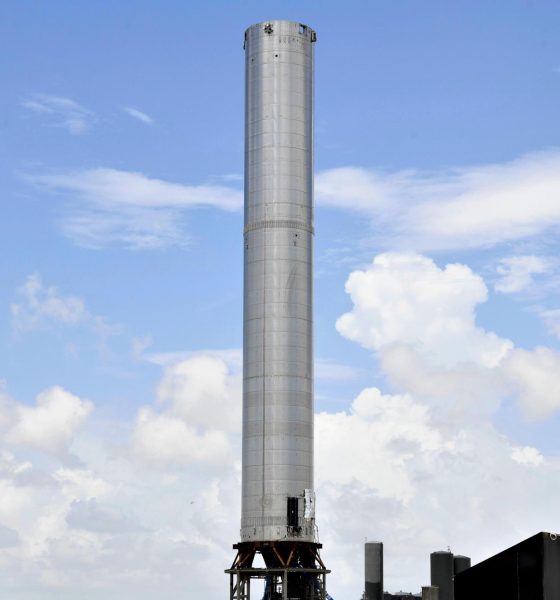

News
SpaceX is building Starship’s first orbital-class booster at a breakneck pace
Within the last week, SpaceX’s South Texas Starship factory appears to have kicked things into high gear and are now assembling the first orbital-class Super Heavy booster prototype at a breakneck pace.
While the assembly of the Super Heavy known as Booster 4 (B4) wasn’t too dissimilar to what CEO Elon Musk described as a “very hard” build of Booster 3 up to last week, work on the rocket has visibly accelerated. Since January 2020, the process of building Starships and Super Heavy boosters has been fairly simple. Both onsite and offsite, raw materials (mostly sheet steel) are cut, bent, and welded into relatively small parts that then make their way to (or around) Boca Chica by truck, forklift, or crane.
With the help of jigs and good amount of automation, the resulting hardware is then welded together to form domes, header tanks, transfer tubes, tank barrels, flaps, and more. Once subassembly is complete, those integrated rocket sections are reinforced with stringers, ribs, and baffles and outfitted with mechanisms, hardpoints, brackets, plumbing, and more. Finally, final assembly – better known as stacking and by far the most visible step – can begin and technicians stack each of those premade segments on top of each other to form a complete Starship or Super Heavy.
While part fabrication and subassembly integration take weeks or months on their own, those earlier steps can be done concurrently, meaning that SpaceX can prepare sections for several different ships and boosters at the same time. For the last six or so months, at any given moment, SpaceX has had 40-60+ rings in work as part of 15-20+ different ring ‘sections’ visible all across Starbase.
Respectively, each Starship and Super Heavy booster require 20 and 36 rings apiece, while each of the propellant storage tanks SpaceX itself is building for the rocket’s first orbital launch pad require 12-15. All told, SpaceX usually has a combination of around 3-5 ships, boosters, and GSE tanks in some stage of assembly. Unsurprisingly, some assembly tasks are harder than others and building the first in a series of prototypes has almost invariably taken far longer than building those that follow.
| Booster 3 | Booster 4 | |
| LOx tank start | May 20th | July 16th |
| LOx tank finish | June 18th | July 30th |
| CH4 tank start | June 24th | July 28th |
| CH4 tank finish | June 27th | July 29th |
| Final stack | June 29th | Aug 1st? |
In that sense, it’s not a huge surprise that SpaceX’s Booster 4 assembly has quickly surpassed the pace set with Booster 3 less than a month earlier. SpaceX began stacking Super Heavy B3 around May 20th, starting with the rocket’s aft liquid oxygen (LOx) tank. Five separate stacks are required to turn the LOx tank’s 23 steel rings into a single structure – a process that took SpaceX about a month with Booster 3.
Booster 3 methane (CH4) tank assembly began a few days after the LOx tank’s completion but proceeded far more quickly, wrapping up just a few days later. Two days after that, those two tank sections were then mated and welded together to complete Booster 3’s full ~65m (~210 ft) tall airframe.
Now, just four weeks after Booster 3 was rolled to the launch pad for proof and static fire testing, Super Heavy Booster 4 is well on its way to reaching its full ~65m height almost twice as quickly. With work beginning around July 16th, B4’s oxygen tank is now just missing an (extremely complex) engine section and the booster’s methane tank was stacked to completion – 13 rings tall – in less than two days. That leaves SpaceX’s first potentially flightworthy, orbital-class Super Heavy booster just two stacks away from completion less than two weeks after its assembly began.
If SpaceX can sustain that pace for another few days, Booster 4 assembly will be the fastest of any full-height prototype ever built at Starbase, most of which have been Starship prototypes that are half to about three quarters the size of Super Heavy.

News
Tesla FSD Supervised wins MotorTrend’s Best Driver Assistance Award
The decision marks a notable reversal for the publication from prior years, with judges citing major real-world improvements that pushed Tesla’s latest FSD software ahead of every competing ADAS system.

Tesla’s Full Self-Driving (Supervised) system has been named the best driver-assistance technology on the market, earning top honors at the 2026 MotorTrend Best Tech Awards.
The decision marks a notable reversal for the publication from prior years, with judges citing major real-world improvements that pushed Tesla’s latest FSD software ahead of every competing ADAS system. And it wasn’t even close.
MotorTrend reverses course
MotorTrend awarded Tesla FSD (Supervised) its 2026 Best Tech Driver Assistance title after extensive testing of the latest v14 software. The publication acknowledged that it had previously criticized earlier versions of FSD for erratic behavior and near-miss incidents, ultimately favoring rivals such as GM’s Super Cruise in earlier evaluations.
According to MotorTrend, the newest iteration of FSD resolved many of those shortcomings. Testers said v14 showed far smoother behavior in complex urban scenarios, including unprotected left turns, traffic circles, emergency vehicles, and dense city streets. While the system still requires constant driver supervision, judges concluded that no other advanced driver-assistance system currently matches its breadth of capability.
Unlike rival systems that rely on combinations of cameras, radar, lidar, and mapped highways, Tesla’s FSD operates using a camera-only approach and is capable of driving on city streets, rural roads, and freeways. MotorTrend stated that pure utility, the ability to handle nearly all road types, ultimately separated FSD from competitors like Ford BlueCruise, GM Super Cruise, and BMW’s Highway Assistant.
High cost and high capability
MotorTrend also addressed FSD’s pricing, which remains significantly higher than rival systems. Tesla currently charges $8,000 for a one-time purchase or $99 per month for a subscription, compared with far lower upfront and subscription costs from other automakers. The publication noted that the premium is justified given FSD’s unmatched scope and continuous software evolution.
Safety remained a central focus of the evaluation. While testers reported collision-free operation over thousands of miles, they noted ongoing concerns around FSD’s configurable driving modes, including options that allow aggressive driving and speeds beyond posted limits. MotorTrend emphasized that, like all Level 2 systems, FSD still depends on a fully attentive human driver at all times.
Despite those caveats, the publication concluded that Tesla’s rapid software progress fundamentally reshaped the competitive landscape. For drivers seeking the most capable hands-on driver-assistance system available today, MotorTrend concluded Tesla FSD (Supervised) now stands alone at the top.
News
Elon Musk’s Grokipedia surges to 5.6M articles, almost 79% of English Wikipedia
The explosive growth marks a major milestone for the AI-powered online encyclopedia, which was launched by Elon Musk’s xAI just months ago.

Elon Musk’s Grokipedia has grown to an impressive 5,615,201 articles as of today, closing in on 79% of the English Wikipedia’s current total of 7,119,376 articles.
The explosive growth marks a major milestone for the AI-powered online encyclopedia, which was launched by Elon Musk’s xAI just months ago. Needless to say, it would only be a matter of time before Grokipedia exceeds English Wikipedia in sheer volume.
Grokipedia’s rapid growth
xAI’s vision for Grokipedia emphasizes neutrality, while Grok’s reasoning capabilities allow for fast drafting and fact-checking. When Elon Musk announced the initiative in late September 2025, he noted that Grokipedia would be an improvement to Wikipedia because it would be designed to avoid bias.
At the time, Musk noted that Grokipedia “is a necessary step towards the xAI goal of understanding the Universe.”
Grokipedia was launched in late October, and while xAI was careful to list it only as Version 0.1 at the time, the online encyclopedia immediately earned praise. Wikipedia co-founder Larry Sanger highlighted the project’s innovative approach, noting how it leverages AI to fill knowledge gaps and enable rapid updates. Netizens also observed how Grokipedia tends to present articles in a more objective manner compared to Wikipedia, which is edited by humans.
Elon Musk’s ambitious plans
With 5,615,201 total articles, Grokipedia has now grown to almost 79% of English Wikipedia’s article base. This is incredibly quick, though Grokipedia remains text-only for now. xAI, for its part, has now updated the online encyclopedia’s iteration to v0.2.
Elon Musk has shared bold ideas for Grokipedia, including sending a record of the entire knowledge base to space as part of xAI’s mission to preserve and expand human understanding. At some point, Musk stated that Grokipedia will be renamed to Encyclopedia Galactica, and it will be sent to the cosmos.
“When Grokipedia is good enough (long way to go), we will change the name to Encyclopedia Galactica. It will be an open source distillation of all knowledge, including audio, images and video. Join xAI to help build the sci-fi version of the Library of Alexandria!” Musk wrote, adding in a later post that “Copies will be etched in stone and sent to the Moon, Mars and beyond. This time, it will not be lost.”
News
Tesla Model 3 becomes Netherlands’ best-selling used EV in 2025
More than one in ten second-hand electric cars sold in the country last year was a Tesla Model 3.

The Tesla Model 3 became the most popular used electric car in the Netherlands in 2025, cementing its dominance well beyond the country’s new-car market.
After years at the top of Dutch EV sales charts, the Model 3 now leads the country’s second-hand EV market by a wide margin, as record used-car purchases pushed electric vehicles further into the mainstream.
Model 3 takes a commanding lead
The Netherlands recorded more than 2.1 million used car sales last year, the highest level on record. Of those, roughly 4.8%, or about 102,000 vehicles, were electric. Within that growing segment, the Tesla Model 3 stood far ahead of its competitors.
In 2025 alone, 11,338 used Model 3s changed hands, giving the car an 11.1% share of the country’s entire used EV market. That means more than one in ten second-hand electric cars sold in the country last year was a Tesla Model 3, Auto Week Netherlands reported. The scale of its lead is striking: the gap between the Model 3 and the second-place finisher, the Volkswagen ID3, is more than 6,700 vehicles.
Rivals trail as residual values shape rankings
The Volkswagen ID.3 ranked a distant second, with 4,595 used units sold and a 4.5% market share. Close behind was the Audi e-tron, which placed third with 4,236 registrations. As noted by Auto Week Netherlands, relatively low residual values likely boosted the e-tron’s appeal in the used market, despite its higher original price.
Other strong performers included the Kia Niro, the Tesla Model Y, and the Hyundai Kona, highlighting continued demand for compact and midsize electric vehicles with proven range and reliability. No other model, however, came close to matching the Model 3’s scale or market presence.








